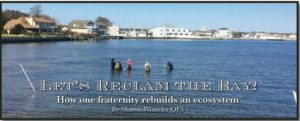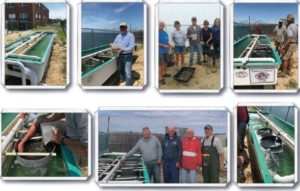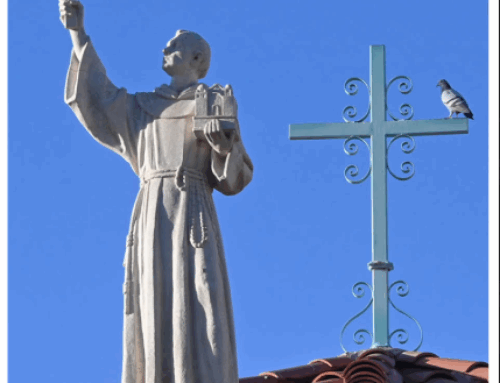(This article originally appeared in the TAU-USA Fall 2020 Issue #101)
How one fraternity rebuilds an ecosystem.
Spirituality, fraternity, science, and some good old elbow grease work together in an apostolate sponsored by the St. Francis of Assisi Fraternity on Long Beach Island, New Jersey.
Taking a page from St. Francis’s love of the environment and Laudato Si, the fraternity works to improve the fragile ecosystem of Barnegat Bay-Little Egg Harbor by raising tens of thousands of clams each year.
Fraternity members participate in the nonprofit Reclam the Bay project sponsored by Rutgers Cooperative Extension. To date, the project has deposited upwards of 10 million clams in the bay since its inception in 2005.
The fraternity joined the effort three years ago after a presentation by Rick Bushnell, president of Reclam the Bay, and we became one of 11 groups in the bay area to host the project.
“We saw it as good volunteer effort, and we liked being able to see a beginning and an end to the project,” said Jim Collery, OFS, one of the team of fraternity members who volunteers on the project.
Work begins in June when 50,000-60,000 clams the size of a pencil head are delivered to the upwellers located on the campus of St. Francis of Assisi Catholic Church on Long Beach Island. Some oysters are also included.
Upwellers are a sort of nursery for clams, which are housed in silo-shaped tanks that have a steady supply of bay water. A sump pump siphons water from the bay, and the clams extract food from it, returning cleaner water back into the bay, said Jim Heimlich, OFS, who organizes the project for the fraternity.
The weekly job of the volunteers is to clean the clam excretions and other debris from the upweller. Some members work cleaning the tubs and cylinders where the clams reside. Others help record statistics such as the temperature and salinity of the water, as well as measuring the size of the clams.
Besides the weekly cleaning and data collection, fraternity members also check regularly to make sure that the water pump is operating. As long as the clams have fresh water, they will continue to breathe and filter the water. If the pump stopped because of a power outage or other factor, the water would lose its oxygenation and the clams would suffocate
The cleaning occurs after 9:30 a.m. Mass on Tuesdays.
Project members welcome children and relish the opportunity to describe how the ecosystem works. They explain how upwellers replenish the clam population, which has been on the decline since the 1980s, when nutrients like nitrogen and phosphorus from sewers and farms flooded the bay and stimulated algae growth. Other factors such as overharvesting also contributed to the decline.
In Laudato Si, Pope Francis states that, “There can be no renewal of our relationship with nature without a renewal of humanity itself” and that is working amidst this project.
“Interfacing with the environment certainly helps build fraternity,” said Heimlich.
Fr. John Frambes, OFM, agreed, “These are good times for fellowship and lots of laughter.”
Fr. Frambes is the fraternity’s spiritual assistant and has a daily view of the upweller from his office window. He regularly volunteers to help clean the upweller.
Fr. Frambes is also called on to the bless the clams at the traditional blessing of the animals each Oct. 4, the Feast of St. Francis of Assisi.
Heimlich says the reclamming project is a way to help the ecosystem.
“The health of the bay clams and oysters are important to the health of the bay. They clean up the chemicals and debris that make it unhealthy for the fish,” he said.
“One oyster filters 40 gallons of water per day. A clam will filter 10 gallons of water per day. Their presence contributes to the health of the environment and helps others in the bay environment thrive,” said Heimlich.
By November, the clams have grown large enough to remove from the upweller and turn over to other volunteers from the Reclam the Bay project, who plant them in protected plots in the bay. The clams are covered by mesh nets to keep crabs, mollusks, and birds from eating them.
A year later, when the clams are 1.5 inches wide, they are distributed in secret locations throughout the bay, where they will continue to grow and reproduce. Any clammers and fishermen lucky enough to find them can harvest them.
Unfortunately, the reclamming project was put on hold this season because of Covid-19 and a storm that damaged a structure next to the upweller that limited access to the area. The fraternity is looking forward to continuing the project next summer.



Leave A Comment